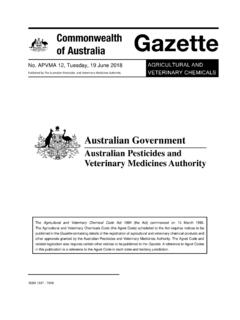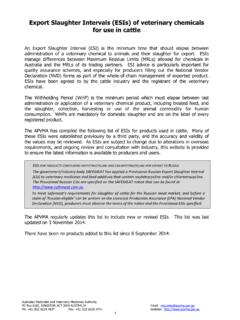Transcription of Australian code of GOOD MANUFACTURING PRACTICE
1 good MANUFACTURING PRACTICEA ustralian code of for veterinary chemical productsThis document was produced by APVMA Quality Assurance and Compliance. Comments and enquiries may be directed to: The Manager, Quality Assurance APVMA PO Box E240 Kingston ACT 2604 Telephone: +61 2 6210 4803 Fax: + 61 2 6210 4813 Commonwealth of AustraliaThis work is copyright. Apart from use permitted under the Copyright Act 1968, no part may be reproduced by any process without prior written permission from the Australian Pesticides and Veterinary Medicines Authority. Requests and inquiries regarding reproduction and rights should be addressed to the Manager, Quality Assurance, Australian Pesticides and Veterinary Medicines Authority, PO Box E240, Kingston ACT 2604, Australia or by email to document is published by the Australian Pesticides and Veterinary Medicines Authority (APVMA).
2 In referencing this document the APVMA should be cited as both the author and published 2007 Web publication date: 29 March 2007 Australian Pesticides and Veterinary Medicines Authority. Australian code of good MANUFACTURING PRACTICE for veterinary chemical productsISBN 97809775766091. Veterinary drugs Law and legislation Australia. 2. Veterinary drugs Standards Australia. 3. Veterinary drug industry Australia Quality control. I. code of good MANUFACTURING PRACTICE for Veterinary Chemical ProductsiInformation about the APVMAThe Australian Pesticides and Veterinary Medicines Authority (APVMA) is the Australian Government statutory authority responsible for the registration, quality assurance and compliance of pesticides and veterinary medicines up to and including the point of retail sale.
3 Prior to their sale in Australia, all agricultural and veterinary chemical products must be shown to work, be safe for people, animals, plants and the environment, and not unduly jeopardise Australia s trade with other nations. The Australian Government and all states and territories have agreed to a National Registration Scheme for Agricultural and Veterinary Chemicals. The Scheme sets out the regulatory framework for the management of pesticides and veterinary medicines in Australia by a single agency. The APVMA is responsible for managing and administering the Commonwealth s regulatory responsibilities under the National Registration Scheme. The APVMA also manages a number of programs aimed at ensuring the safety and performance of pesticides and veterinary medicines.
4 One of these programs involves the licensing of manufacturers of veterinary National Registration Scheme also provides for a national, uniform and cooperative legislative regime for agricultural and veterinary chemicals throughout Australia administered by the APVMA. The cooperative nature of the legislation is set out in the Agricultural and Veterinary Chemicals Act 1994 and complementary Agricultural and Veterinary Chemicals Acts of each state and territory. The Agricultural and Veterinary Chemicals (Administration) Act 1992 lays down the governance principles for the APVMA as an independent statutory authority of the Commonwealth. The centerpiece of the Scheme s legislation is the Agricultural and Veterinary Chemicals code (the Agvet code ) scheduled to the Agricultural and Veterinary Chemicals code Act 1994.
5 The Agvet code provides the operational details for the registration of chemical products by the APVMA as well as for quality assurance and compliance programs for pesticides and veterinary medicines up to and including the point of retail sale in Australia. Part 8 of the Agvet code provides for the licensing of the manufacturers of veterinary medicines by the APVMA, where the manufacturer complies with the APVMA s MANUFACTURING principles . Australian code of good MANUFACTURING PRACTICE for Veterinary Chemical ProductsiiiContentsIntroduction 1 Background to the review 3 Interpretation of the code 4 PART 1 CORE ELEMENTS OF THE code 7 Important Information 7 CHAPTER 1 QUALITY MANAGEMENT 9 MANUFACTURING principles 9 Quality management guidelines 9 Management of quality 9 Quality assurance 9 Quality control 10 Quality and production nominees 10 Process control and change control 10 CHAPTER 2 PERSONNEL AND TRAINING 11 MANUFACTURING principles 11 Personnel and training guidelines 11 General 11 Key personnel 11 Qualifications and experience 12 Training and competency assessment 13 Personal hygiene and health issues 13 CHAPTER 3 BUILDINGS AND GROUNDS 15 MANUFACTURING principles 15
6 Buildings and grounds guidelines 15 General 15 Cleaning and sanitation 16 Storage areas (including receipt and despatch) 17 Production areas 18 Quality control areas 19 Ancillary areas 19 Animal houses 19 Australian code of good MANUFACTURING PRACTICE for Veterinary Chemical ProductsivCHAPTER 4 EQUIPMENT 21 MANUFACTURING principles 21 Equipment guidelines 21 General 21 Equipment qualification and validation 22 Maintenance 22 Calibration 22 Cleaning 23 CHAPTER 5 DOCUMENTATION 25 MANUFACTURING principles 25 Documentation guidelines 25 General 25 Document control 26 Records 27 Documents required 28 Specifications 28 Materials control (stores receipt, storage and disposal) 29 Master MANUFACTURING formula, master batch records and master MANUFACTURING processing instructions 29 Master packaging and labelling instructions 30 Batch MANUFACTURING /processing records 31 Batch packaging records 32 Quality control sampling and testing 33 Release/rejection and distribution of finished product 33 Complaints, recalls and returns 33 Computer records 34 Laboratory records 34 Validation records 34 Other 34 CHAPTER 6 COMPUTER SYSTEMS 35 MANUFACTURING principles 35 Computer systems guidelines 35 General 35 Australian code of good MANUFACTURING PRACTICE for Veterinary Chemical ProductsvCHAPTER 7 PRODUCTION 37 MANUFACTURING principles 37 Production guidelines 37 General 37 Materials control (including storage)
7 37 General 37 Receipt, storage and quality assurance of raw materials 38 Receipt, storage and quality assurance of packaging materials 39 Cross-contamination control 39 Process validation 40 Production procedure 40 Dispensing of raw materials 40 Processing operations 40 Intermediate and bulk products 41 Process water 42 Primary (filling) and secondary packaging operations 42 Release of finished products 44 Residual, rejected, recovered and returned materials 44 CHAPTER 8 QUALITY CONTROL 47 MANUFACTURING principles 47 Quality control guidelines 47 General 47 Documentation 48 Sampling 49 Sampling plans 49 Sampling procedures 50 Retention samples 50 Product release 51 CHAPTER 9 CONTRACT MANUFACTURE 53 MANUFACTURING principles 53 Contract manufacture guidelines 53 General 53 The GMP Agreement 54 The contract giver 54 The contract acceptor 55 Inspection of contract manufacturers 56 Australian code of good MANUFACTURING PRACTICE for Veterinary Chemical ProductsviCHAPTER 10 INTERNAL AUDITS 57 MANUFACTURING principle 57 Internal audit guidelines 57 General 57 CHAPTER 11 COMPLAINTS AND PRODUCT RECALLS 59 MANUFACTURING principles 59 Complaint and product recall guidelines 59
8 Complaints 59 Suspected product defects 60 Recalls 60 PART 2 ANNEXES 61 Important information 61 ANNEX 1 MANUFACTURE OF STERILE PRODUCTS 63 MANUFACTURING principles 63 Introduction 63 General 64 Premises 64 Production areas 64 Sanitation and hygiene 65 Environment control 65 Air quality 65 Environmental monitoring 68 Personnel 68 Equipment 69 Specification for materials 71 Processing 71 Sterilisation by heat general 72 Sterilisation by moist heat 73 Sterilisation by dry heat 73 Sterilisation by radiation 73 Sterilisation by ethylene oxide 74 Sterilisation by filtration 74 Finishing (primary packaging) 75 Quality control 75 Aseptic processing 76 Australian code of good MANUFACTURING PRACTICE for Veterinary Chemical ProductsviiPremises 76 Production areas 76 Sanitation and hygiene 76 Environment control 77 Environmental monitoring 77 Personnel 78 Equipment 78 Processing 79 ANNEX 2 IMMUNOBIOLOGICALS AND OTHER PRODUCTS OF BIOLOGICAL ORIGIN 81 MANUFACTURING principles 81 Essential information 81 Premises 81 General 81 Segregation and containment 82 Sanitation.
9 Disinfection and waste disposal 83 Personnel 84 Equipment 84 Animals and animal houses 85 Production 86 General 86 Starting materials 86 Media 87 Seed lot and cell bank system 87 Operating techniques 87 Quality control 89 ANNEX 3 NON-STERILE THERAPEUTIC PRODUCTS (OTHER THAN ECTOPARASITICIDES, PREMIXES, SUPPLEMENTS AND BIOLOGICAL FEED ADDITIVES) 91 Introduction 91 Liquids, creams, pastes, gels and ointments 91 Powders and tablets 91 Products containing penicillins and other highly sensitising antibiotics 91 Electrolytes 91 Bloat oils 92 Slow-release intra-ruminal devices 92 Premises and equipment 92 Production 92 Australian code of good MANUFACTURING PRACTICE for Veterinary Chemical ProductsviiiANNEX 4 HERBAL PRODUCTS 93 Introduction 93 Premises 93 Storage areas 93 Documentation 93 Specifications for starting materials 93 ANNEX 5 ECTOPARASITICIDES 95 Introduction 95 Buildings and grounds 95 Manufacture 96 ANNEX 6 PREMIXES.
10 SUPPLEMENTS AND BIOLOGICAL FEED ADDITIVES 97 Introduction 97 Premixes and supplements 97 Introduction 97 Buildings and grounds 97 Personnel 98 Equipment 98 Process control 98 Mined mineral supplements 98 Direct-fed microbials and enzyme products 98 Introduction 98 Buildings and grounds 99 Personnel 99 Process control 99 Materials control 99 Production control 100 Enzyme recovery 100 GLOSSARY 101 Australian code of good MANUFACTURING PRACTICE for Veterinary Chemical Products1 IntroductionVeterinary chemical products are subject to a registration process that requires them to be fit for their intended use and to not place treated animals or users at risk due to inadequate safety, quality or efficacy. Veterinary chemical products must be manufactured in such a way that they comply with their registered particulars and that there is batch-to-batch ultimate responsibility for attaining these quality objectives lies with senior management, but their attainment also requires the participation and commitment of all staff, at all levels, within the MANUFACTURING organisation.






